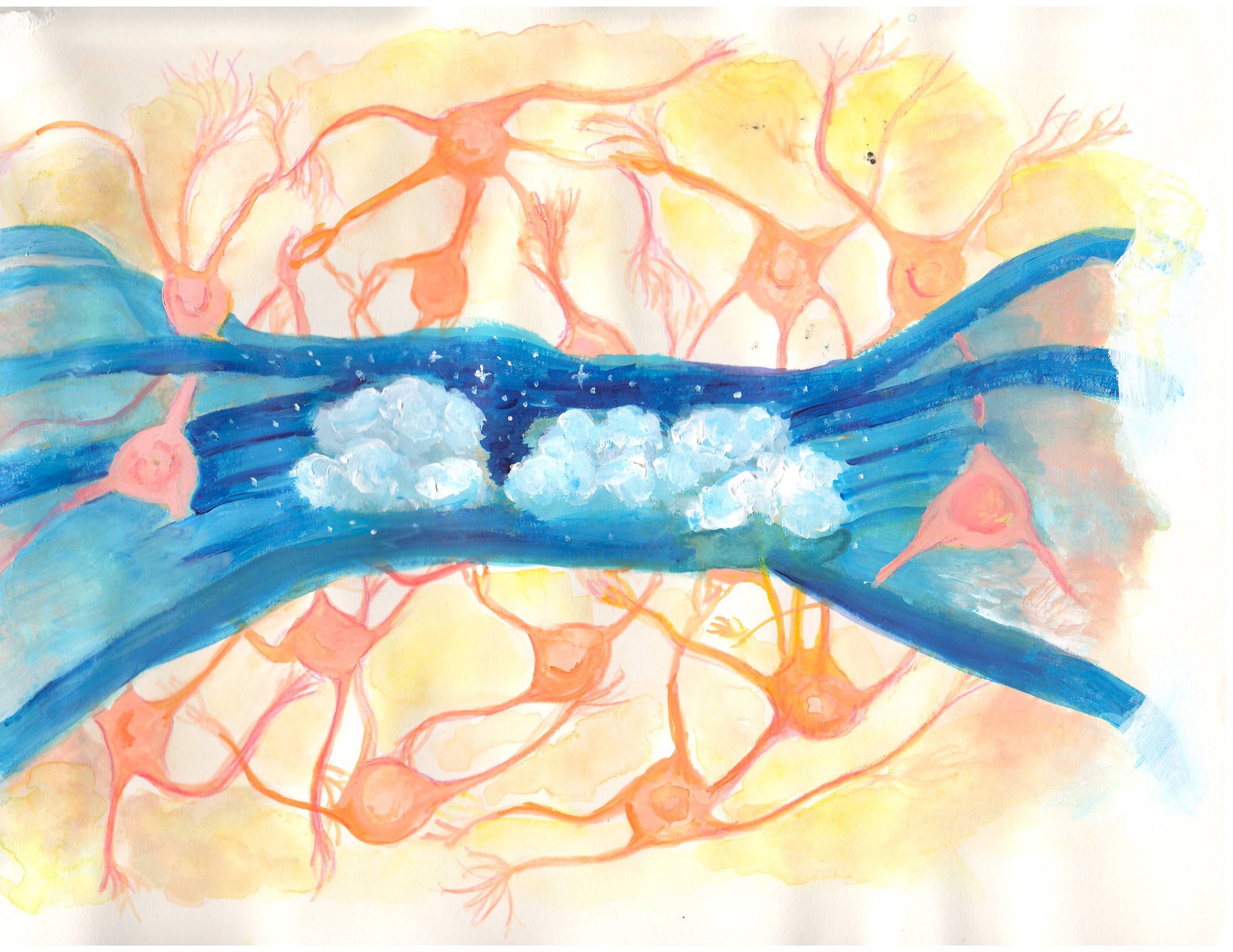Many college students discount the importance of sleep; whether it is to stay up cramming for a test, or to play a new game that was just released, students simply undervalue the benefit of a good night’s sleep. However, we have all heard that sleep is important for our brain function, our sense of wellbeing, and our memory retention. In fact, these ideas have been around for centuries; the Roman rhetorician Quintilian noted “what could not be repeated at first is readily put together on the following day; and the very time which is generally thought to cause forgetfulness is found to strengthen the memory” [1]. Quintilian observes here that sleep, which we used to think of as a time of forgetting, is actually when memory is strengthened. That was only the first of many observations and studies done on how sleep and memory are related. At the forefront of sleep and memory research today is the idea that the brain can be exposed to external stimuli during sleep which reactivate and strengthen neural pathways associated with memories made during the day. This technique, called Targeted Memory Reactivation (TMR), relies on learning material with certain audible cues present and then replaying those cues during certain points in a person’s sleep cycle in order to promote the reactivation of memories. Using audible cues to reactivate these memories aims to help improve the retention of that material. Modern research is constantly affirming the link between sleep and memory consolidation, and using targeted memory reactivation could be the next step in harnessing the power of sleep to help you improve your memory.
One of the important steps in the TMR process is sleep, and one of the first hypotheses on why sleep was important to memory consolidation was the idea that while you’re awake your brain quickly encodes everything you experience into a short-term storage, and because you are getting new information constantly, these memories can be damaged and corrupted by this new interfering information [2]. Early sleep studies showed that sleeping right after subjects learned material helped them remember, showing that sleep was key factor in the memory process [3][2]. Later, researchers began to focus on how the different stages of sleep affected the memory consolidation process. When you first fall asleep, you are mainly in slow wave sleep (SWS), characterized by slow “brain wave” activity, which can be visualized as slow, high-amplitude waves on an electroencephalogram (EEG). It has been shown that during SWS, different types of neurons work best together and mediate memory reactivations, which is why this time is the most important for TMR. As your night goes on, SWS decreases in intensity and duration and rapid eye movement (REM) sleep takes over [2].
These two respective stages of sleep each have their own role to play in the memory consolidation process. The current model for human memory suggests that we have a two stage memory system [2]. “Recording” the memory is the first step in the process of making a memory, and your hippocampus, the part of your brain located close to the brain stem responsible for learning and memory, is highly involved in this [4]. During this step, the newly formed memory is highly susceptible to external influences that may cause the brain to change the memory or forget it completely. In the second step, the brain essentially replays the memory and strengthens the neural pathway that represents the memory, as well as weaving it into the existing memory network [2]. This step happens during sleep and involves both the hippocampus and the neocortex. The neocortex is responsible for higher functions such as sensory perception, motor commands and language [5]. The hippocampal neurons that represent the memory are repeatedly activated, therefore “replaying” the memory. Then these reactivations of the neural network propagate to the neocortex where the neocortex takes the memories and integrates them into pre-existing long-term memories. The importance of the hippocampus to memory consolidation is supported by studies that show that lesions in the hippocampus destroy the ability to form new memories but keep old memories intact [2]. Other evidence linking sleep and memory comes from observing the hippocampal neuron activity in sleeping rodents, and that this activity occurs preferentially during SWS [6]. During SWS, the hippocampus replays the neuron firing patterns associated with a memory made during the day, and this causes the formation of stable long-term memories [3]. The aforementioned studies support the two stage memory system model, because they all suggest that the encoding process is seperate from the long-term storage of memories.

Targeted Memory Reactivation (TMR)
Targeted Memory Reactivation (TMR) is a technique that harnesses the power of sleep and re-exposure to certain cues to help promote better memory consolidation. These cues are first introduced as a noise or a certain smell presented as one learns the material to be remembered. Then the same cue would be presented while one is asleep, quiet and unobtrusive enough so as not to wake the person. The majority of TMR studies have used auditory cues that are unrelated to the material being learned, such as melodies or artificial sounds, however, recent work has shown some benefit of contextual verbal cues in a linguistic learning setting [7]. Further investigation is needed to confirm the results, but one study’s findings suggest that there might be two processing routes for memory retrieval during sleep; one that is for specific memories and one for a general memory web retrieval [7].
As the name suggests, TMR uses targeted “re-activation” of memories through auditory or olfactory cues to boost the transition of short-term memories into stable long-term memories [6]. When the test subjects were tested on their material again, the material that was cued during sleep was retained better than similar material that did not have the subtle input attached to it [8]. TMR has been tested in sleep labs for about a decade now, and only recently has been tested by subjects doing unsupervised tests at home. This is because, in sleep labs, it is easy to control the environment of the sleeper and to control important variables such as making sure the participants really are asleep, stopping the auditory cues should they wake up, and making sure that the cues are presented during SWS [8]. The correlation between cues being presented during SWS shows a stronger boost in memory retention than when the same cues were presented during REM, where the expected memory benefits did not occur [6]. This suggests SWS is a better time for memory consolidation, and the general conclusion seems to be that the slow-wave oscillations allow for better communication between the hippocampus where the short-term storage is and the long-term storage neocortex [9].

There are several intriguing aspects of TMR I would like to talk about. First, different types of memories are affected by TMR in different ways. Second, how effective is TMR at helping to retain a memory? Finally, most of these experiments were done in a sleep lab in a controlled setting: how could this information be applied to everyday life?
It is important to first note that TMR affects different types of memories in different ways, and that some cues and tasks may be better suited for this technique than others. A study done by Antony and colleagues found that TMR can strengthen skill learning. His study had participants learn to play two short melodies on a system that resembles Guitar Hero. After learning these melodies, some participants were presented with one of the tunes during SWS, and after sleep, those participants were reliably more accurate at performing the cued melodies than participants who were not cued during sleep [6]. This type of memory is known as a “non-declarative memory” which encompases motor skills, while the other broad category of memory is known as “declarative memory” which is often more related to facts or general information [1]. Findings also suggest that when emotionally negative and neutral memories are reactivated together, the ensuing SWS supports only the consolidation of the negative memories [10]. Prior memory studies have shown this to be true as well: that the human brain selectively remembers information with more emotion attached to the memory. Another study, that documented the first example of memory reactivation during sleep in humans, showed a sleepwalker performing a structured sequence of movements during SWS when exposed to a certain external stimuli that had been present when he learned the sequence earlier [6][10]. These studies all seem to indicate that TMR preferentially affects non-declarative memories and emotionally charged memories. The question remains: just how effective is TMR? In this context, effective is taken to mean how well does TMR assist in conscious memory recall. Indeed, most studies have found a beneficial effect of TMR in the form of higher recall accuracy for the cued objects compared with uncued objects. This means that when cues for the material to be learned were played during SWS, the participant’s retention of the material was significantly better. Several studies also show that the benefit of TMR was greater for those who already had a higher pre-sleep recall accuracy [9]. This benefit was seen both on a behavioral level where the participants scored higher and could be seen on brain scans with an improved neural activity [9][11]. Still other studies suggest that there are also correlations between level of activation and memory improvement as well as duration of sleep and time spent in SWS [6].
Lastly, let’s address the fact that most research thus far has been done in a sleep lab under very controlled conditions. This being said, how is TMR relevant to anything except further sleep research? Interestingly, there actually have been studies that focus on unsupervised TMR performed by test subjects in their own homes. One study focused on auditory cues and tested vocabulary learning of adults, and one focused on olfactory cues and tested the vocabulary learning of children [8][12]. The participants of the auditory study were instructed to learn Dutch-German word pairs over 4 consecutive nights. During the learning phase, the participants first heard a new Dutch vocabulary word and then saw the German translated word on the screen in front of them. They were then tested by listening to all the words and typing out the German translation. To test the efficacy of TMR, the program randomly selected and created an audio file of an even mix of their correctly and incorrectly translated words, and had the participants listen to the audio file in their sleep. The general conclusion was that for those people who did not report sleep disturbances, the at home TMR generally improved memory for the “cued” words. Another detailed analysis revealed that only by the third night were there significant benefits. Since the study was done unsupervised, there were several participants who were woken up by the audio recording, and the people who reported these specific disturbances in sleep showed no benefit to impairment of memory. The second successful study was done with a group of children who were also learning vocabulary words, but they learned them in the presence of a rose scent. The children that were exposed to both the cues while learning the material the first time and again while they were sleeping showed improvement in their vocabulary recall. This study concluded that odor cues can work in a home setting, be presented the entire night, not just during specific sleep portions, and that there is a possibility presenting the cues again when the material is being re-tested after TMR also could have benefits. These results are promising for the future of using this technique at home, because olfactory cues can be presented throughout the whole night without waking the subject [12]. This would eliminate the volume control and and sleep cycle timing issues presented by using auditory cues for TMR.
While it remains relatively unclear just how effective TMR would be if implemented by people at home, there is hope for the future of using this technique at home as shown by the odor study. The areas to still be explored with TMR include running more unsupervised trials, improving the at-home usage of this technique, and delving into how related the cues have to be to the material being learned. However, there have been multiple different studies over the last decade showing that this technique is something that leads to statistically higher memory retention rates for the participants who used TMR, and with the new study showing promising benefits of olfactory TMR, this technique might be something future college students will be trying. The goal of this technique is to improve memory retention, so this would never be a way for people to study while they sleep. However, your sleeping brain might be able to give you that little bit of a boost you need come exam day.
References
- Stickgold, R. (2005). Sleep-dependent memory consolidation. Nature, 437(7063), 1272–1278. https://doi.org/10.1038/nature04286
- Rasch, B., & Born, J. (2013). About sleep’s role in memory. Physiological Reviews, 93(2), 681–766. https://doi.org/10.1152/physrev.00032.2012
- Klinzing, J. G., Niethard, N., & Born, J. (2019). Mechanisms of systems memory consolidation during sleep. Nature Neuroscience, 22(10), 1598–1610. https://doi.org/10.1038/s41593-019-0467-3
- Anand, K. S., & Dhikav, V. (2012). Hippocampus in health and disease: An overview. Annals of Indian Academy of Neurology, 15(4), 239–246. https://doi.org/10.4103/0972-2327.104323
- Neocortex (brain). (n.d.). ScienceDaily. Retrieved February 10, 2020, from https://www.sciencedaily.com/terms/neocortex.htm
- Oudiette, D., & Paller, K. A. (2013). Upgrading the sleeping brain with targeted memory reactivation. Trends in Cognitive Sciences, 17(3), 142–149. https://doi.org/10.1016/j.tics.2013.01.006
- Cairney, S. A., Sobczak, J. M., Lindsay, S., & Gareth Gaskell, M. (2017). Mechanisms of Memory Retrieval in Slow-Wave Sleep. Sleep, 40(9). https://doi.org/10.1093/sleep/zsx114
- Göldi, M., & Rasch, B. (2019). Effects of targeted memory reactivation during sleep at home depend on sleep disturbances and habituation. NPJ Science of Learning, 4, 5. https://doi.org/10.1038/s41539-019-0044-2
- Creery, J. D., Oudiette, D., Antony, J. W., & Paller, K. A. (2015). Targeted Memory Reactivation during Sleep Depends on Prior Learning. Sleep, 38(5), 755–763. https://doi.org/10.5665/sleep.4670
- Cairney, S. A., Durrant, S. J., Hulleman, J., & Lewis, P. A. (2014). Targeted memory reactivation during slow wave sleep facilitates emotional memory consolidation. Sleep, 37(4), 701–707, 707A. https://doi.org/10.5665/sleep.3572
- Groch, S., Schreiner, T., Rasch, B., Huber, R., & Wilhelm, I. (2017). Prior knowledge is essential for the beneficial effect of targeted memory reactivation during sleep. Scientific Reports, 7(1), 39763. https://doi.org/10.1038/srep39763
- Neumann, F., Oberhauser, V., & Kornmeier, J. (2020). How odor cues help to optimize learning during sleep in a real life-setting. Scientific Reports, 10(1), 1–8. https://doi.org/10.1038/s41598-020-57613-7
